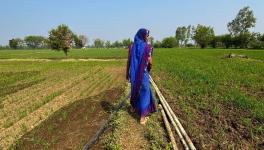Lockdown Distress: A Saga of Rising Household Debts, Ebbing Incomes
Representational use only.
On March 24, 2020, Narendra Modi had announced that the country would go into a lockdown after four hours! This nation-wide lockdown was to last till the end of May, after which there were local lockdowns but not a general one. It brought acute hardship to millions of the working poor, among whom migrant workers’ woes received global attention.
What was striking about the Indian lockdown was that, in contrast to virtually everywhere else, including the US under Donald Trump, no compensation was offered to the people (except paltry amounts to a few specific target groups) for their loss of incomes because of the lockdown. They were pushed into a situation of income loss, destitution and hunger, from which they had not recovered even months after the lifting of the lockdown.
This phenomenon of non-recovery is documented by a survey called Hunger Watch, carried out by several civil society organisations which undertook a survey in October. This is not a survey based on any representative sample; nor does it record any statistics of expenditure. It just asks people, chosen because of the organisations’ access to them, about their own impressions. And these impressions are revealing.
More than half (53.5%) of the nearly 4,000 respondents reported that their household consumption of rice and wheat had gone down in October compared with March. The percentage reporting a decline in household consumption of pulses, green vegetables, eggs and meat was even higher.
This is consistent with the other finding of the survey that over 62% of the respondents felt that there had been a decline in the household monthly income between before the lockdown and October. It is because of this that there had also been an increase in the labour force participation rate compared with before the lockdown: more people were forced to join the labour force looking for work owing to their worsening material conditions.
It may be argued that the sample of respondents is not representative, because of which no general conclusions can be drawn from such findings. The important point, however, is that even if there is an increase in hunger because of the lockdown for some particular groups, then that itself is of great significance; in fact, Hunger Watch concentrated especially on vulnerable groups.
The other surprising finding of Hunger Watch is that the percentage of respondents reporting a decrease in consumption between pre-lockdown days and October, is larger in urban areas compared with rural areas. This is contrary to expectations. Typically, acute hunger and malnutrition are associated more with rural than with urban areas, just as poverty defined in nutritional terms has always been consistently higher in rural than in urban India. So, to find that the increase in hunger because of the lockdown was greater in urban India, comes as a surprise.
There are two obvious answers to this puzzle. One is the absence of ration cards among the urban poor who were, therefore, denied access to the public distribution system. The other is the fact that the MGNREGS (rural job guarantee scheme) provided some support to the rural population in this period of acute distress, but the absence of any such scheme in urban India meant that distress was unmitigated and hence greater.
A number of important conclusions can be drawn from the Hunger Watch report. Because of the absence of almost any support during the period of lockdown, distress and destitution during the lockdown itself was inevitable. What is striking, however, is that this distress continued and remained acute even after the lockdown was over. The usual belief is that a lockdown disrupts production but when it gets lifted, production should get back to normal; but this, while valid if the working people’s incomes are maintained during the lockdown through fiscal transfers, is wrong when they are not, as in India’s case.
Suppose, to start with, that the working people’s incomes are maintained during the lockdown. Then their demand for foodgrains and other consumption goods does not go down; nor does their debt increase for maintaining their demand. And this demand is met by sellers through running down inventories of goods since production has come to a stop. Hence, when the lockdown gets lifted and incomes flow to the workers from productive activities (eliminating the need for fiscal transfers), consumption demand remains as before; in addition, replenishing inventories adds to the normal level of demand, so that production would be even larger than before.
On the other side, if working people’s incomes become zero during the lockdown, then they have to cut back on consumption, and also borrow to meet this lower level of consumption. And when the lockdown gets lifted, even if we assume that production recovers to the earlier level, demand will be less because what the working people had borrowed has to be paid back with interest from their incomes. Demand, therefore, does not recover to the old level (until the debt has been repaid).
For this very reason, however, production, which responds to demand, will itself never get back to the original pre-lockdown level. The economy then never recovers fully to the old level of production and consumption. Not only do the people suffer distress, because their incomes remain depressed and their debt burden increases even while their consumption remains below what it was before the lockdown, but the economy’s recovery remains truncated.
Both economic recovery and alleviating economic distress, therefore, require the maintenance of incomes of the working people through fiscal transfers during the lockdown. The Modi government, in its utter mindlessness, not only did not do this, but brought the incomes of the large bulk of the working people to zero. The Hunger Watch findings are important precisely because these establish its consequences.
Finance minister Nirmala Sitharaman has said that the economic recovery will be stimulated by the Centre’s spending on the backlog of unfinished infrastructure projects. The real question here is: how much spending? If the level of spending is the same as before the lockdown, then, because the working people’s consumption has to go down in the post-lockdown period compared with before the lockdown (owing to their need to repay debt), the overall level of demand in the economy will be lower than before. Hence, the level of production, too, will be lower than before the lockdown, i.e., recovery will remain truncated.
For a full recovery, therefore, it is necessary that the level of spending on infrastructure and other such projects must be much higher than before the lockdown, to compensate for the lower demand coming from the working people (because of their need to pay back debts incurred owing to loss of incomes during the lockdown).
It is far better, however, to stimulate the economy, not through infrastructure projects but by giving direct cash transfers to the working people even after the lockdown is over. And the amount of transfers must be such that at the old level of output, the incomes generated for the working people from productive activity plus the fiscal transfers to them together match the old level of consumption expenditure plus their debt-cum-interest payment. Only in such a case can the economy get back to the old level of output. In other words, not making such transfers during the lockdown leaves its imprint later as well: transfers have also to be made after the lockdown if recovery is to be stimulated.
Giving cash transfers is a better way to stimulate recovery because, apart from alleviating distress, such transfers also get spent on simple domestically produced goods with lower import content; this generates, per unit of government expenditure, larger home demand and hence output and employment.
Government expenditure in this context must not be taken to mean what is required for giving free foodgrains to workers. Free foodgrains, though beneficial, do not stimulate the economy at all, since their distribution is effected by decumulating Food Corporation of India stocks. It is the cash transfers over and above this which have the effect of stimulating the economy.
The Opposition leaders’ letter to the Prime Minister had demanded Rs 6,000 per month of cash transfers per household to all jobless. Even assuming that every working household in the country gets this much for a period of three months, the total expenditure would come to less than 2% of the GDP, which is perfectly manageable.
The Modi government, however, is as timid as it is mindless. It persists with its fiscal conservatism even when the economy is in acute crisis and people are in acute distress.
Get the latest reports & analysis with people's perspective on Protests, movements & deep analytical videos, discussions of the current affairs in your Telegram app. Subscribe to NewsClick's Telegram channel & get Real-Time updates on stories, as they get published on our website.
























